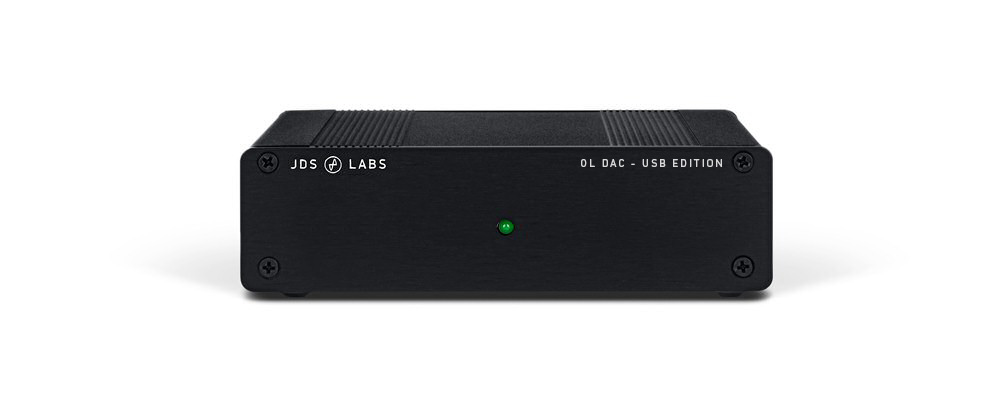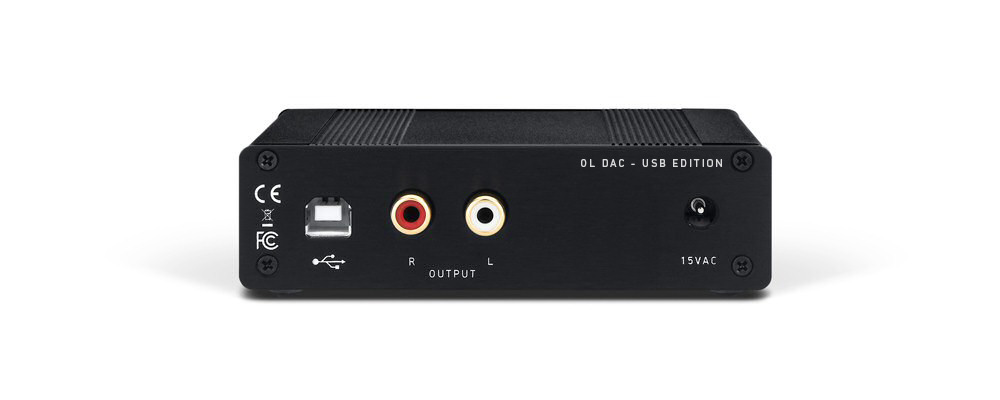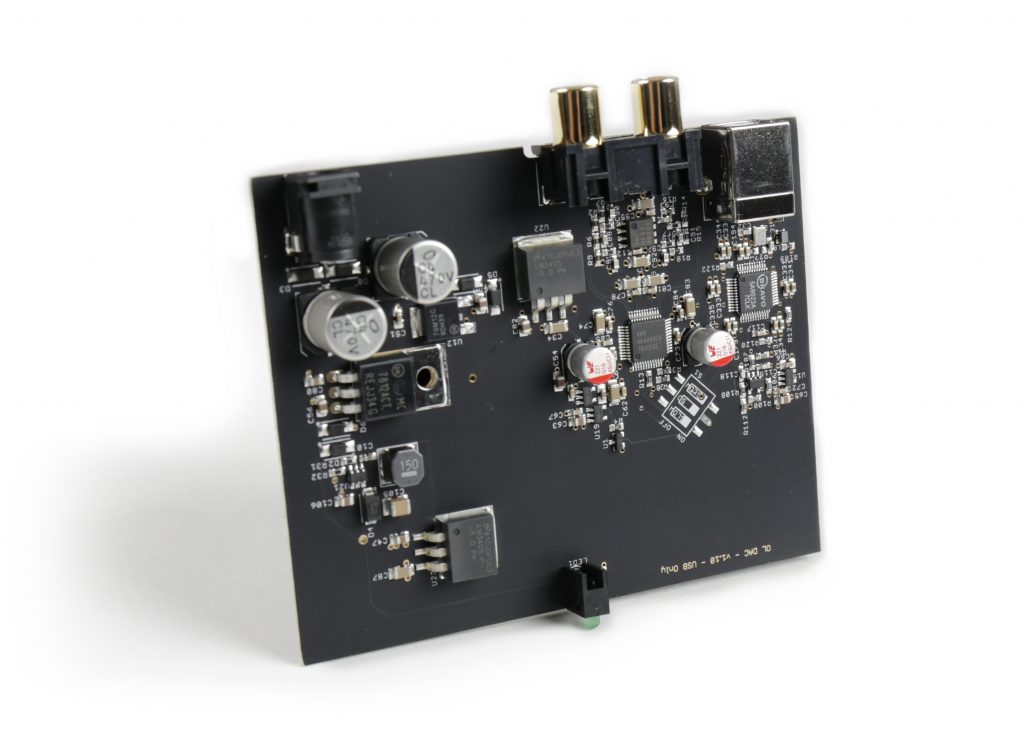With the growing success of OL DAC, JDS Labs presents OL DAC – USB Edition:

 As we doubled the size of our most recent OL DAC production run, we acknowledged that only some of you add TOSLINK cables to your cart. Most only want USB input and never touch the optical jack. So, we removed the unnecessary S/PDIF controller and I2S routing circuitry to create OL DAC – USB Edition.
As we doubled the size of our most recent OL DAC production run, we acknowledged that only some of you add TOSLINK cables to your cart. Most only want USB input and never touch the optical jack. So, we removed the unnecessary S/PDIF controller and I2S routing circuitry to create OL DAC – USB Edition.
OL DAC – USB Edition offers driverless USB audio and remains 100% AC powered, like the original OL DAC, now aptly titled Optical + USB Edition. All performance meets or exceeds that of the original OL DAC. We’re pleasantly surprised to report that removal of the I2S MUX bumps USB Jitter components @11025Hz from an already excellent -116dB to -120dB!
|
OL DAC Optical + USB Edition |
OL DAC
USB Edition |
Standalone ODAC | |
| Price | $139 | $99 | $149 |
| USB Input | Yes | Yes | Yes |
| Optical Input | Yes | No | No |
| Muting Relay | Yes | No | No |
| AC Powered | Yes | Yes | No |
For a deeper technical comparison, please see ODAC vs. OL DAC.
*Update Nov 19, 2017*
Since posting this announcement on Wednesday, several have asked, “What is relay muting?”
Relay muting means that the DAC creates absolutely no pops or thumps when turned on/off. Many amplifiers and DACs on the market may make a sound when turned on or off, which can be bothersome in some situations, especially with large speakers or sensitive headphones.
OL DAC Change Log
- v1.10 USB Edition – November 2017: Same as v1.10, minus optical input and relay muting.
- v1.10 – July 2017: Added relay muting.
- v1.00 – November 2016: Initial release.


Great…..
Now plz make optical only dac to connect TV or hi-fi system without using computer in this price range…..
‘Optical only’ is actually how OL DAC began. Few early testers could find a use for it, and demanded USB instead. So we released OL DAC with both USB and optical inputs. Then many asked for USB Only, so we removed the optical circuit recently. Demand would need to be 10x higher to warrant releasing an optical only version.
Thus, the original OL DAC is your best option at only $139.
Ok now I will give u a better idea….
Try to make OPTICAL+COAXIAL version of OL DAC ……..PLZ
Because now every modern audio player comes with COAXIAL OUT function (all fiio players)
It will be worth using as standalone dac for home without using computer plz think about it….
I m Being greedy…..
One more idea…….
I am using ol dac (optical + USB) version with my jbl lsr305 and it work fine with my computer.
But when I purchased my Samsung 32m5570 TV which have Bluetooth (2way) and optical out …..
Now I m using ol dac connected with optical out of TV and stream my music through mobile and I found no degradation in sound quality..
So….. Bluetooth in
Hello, you mentioned the lack of the muting relay. Why did you chose not to include it in the USB version? Can the lack of this relay be damaging to an amplifier and or speakers? Does this relay kick on and off when music is not playing and starts playing, or is the relay for only when the unit is physically turned on and off? I have a Fiio X5 III that kicks the relay in and out when switching between songs, etc. It’s annoying. Where as the amplifier, the A5 kicks the relay on once the unit has been turned on, and stays engaged, music playing or not.
The muting relay can be considered a nice feature; it is not required for safe operation. The only purpose is to eliminate slightly annoying startup/shutdown transients. It is omitted in the USB Edition in order to achieve optimal value.
I’m looking to buy this DAC, however I want to hook it up to both my amp and my Fiio A5 headphone amp at the same time. That way whenever I have to switch between them I don’t have to keep unplugging/plugging in the RCA cables, yucky. I’m guessing my best bet would be an RCA splitter, or Y adapter as they are called. I don’t want to take a hit in performance.. and every adapter I’ve had has been flaky. Do you know which one is the highest quality you would recommend? I’m currently looking at SVS, but never heard of them before. https://www.svsound.com/products/gold-rca-y-adapter
Although they say the use case is for subwoofers, they seem to perform the same exact function I’m looking for.
Future suggestion for when you go to make your next DAC, dual RCA outputs like other DACs offer for this purpose.
Thank you.
Victor – Switched outputs are built into Atom Amp (preamp output) and Element (fixed line-output). In general, such a splitter should be avoided, as input impedance of some loads can compromise performance. OL DAC itself perform fine with a splitter.
Thanks for the reply. Excellent service, thus why I’m going to purchase from you. I might end up just buying 2 of these units. Another question, what LPF does this DAC use? Looks like a JRC something.
Victor – OL DAC uses NJRC4556 in its LPDF/summing output stage. It’s well suited for directly driving any headphone load, or a paralleled loads.
See that doesn’t make any sense to me. This is a DAC not a headphone amplifier. The RCA outputs should be line-level and not intented to directly hook up headphones too. So saying it can drive any headphone load makes no sense to me. This isn’t a headphone amplifier?! But hey, I’m not the electrical engineer. I was asking the LPF because I’ve heard this is a critical compnent sound quality wise on the analog side of the DAC and can be just as important as the DAC chip selected. Unless I heard wrong.. I see others using say the OPA1642, how does this compare?
Victor – Sorry to confuse. The AK4490 provides differential outputs. These outputs must be summed to generate unbalanced line-level outputs. The summing process and LPF are the same circuit. Yes, OL DAC’s summing/LPF stage is a 2VRMS line-level DAC output as you expect. It just so happens that this output stage is also well suited to directly drive any load thanks to its low output impedance and decent output current capability. This capability has been mentioned in the past. Feel free to disregard this information if it’s irrelevant to you.
As for comparison to other opamps, you may find this article helpful:
http://nwavguy.blogspot.com/2011/08/op-amps-myths-facts.html
NJM4556 performs quite well. I have not tried OPA1642 in the OL DAC circuit, so I cannot comment on its relative performance in this circuit.
Paul’s explanation of other AK ICs is right on. Please also note that DAC performance is primarily determined by noise level of the power supply circuitry, followed by THD and Noise of the differential summing output stage. Dropping a more expensive IC into a given design may or may not be beneficial!
John, thanks for the reply. I did not mean to come off disrespectful or rude in this. I was just curious. I wasn’t implying that I was going to modify the OL DAC or circuitry in any way. I was just moreover curious about why you chose said opamp as I haven’t seen it used by others and said chip appears to be really old. I just mentioned the OPA1642 cuz that seems to be one of the chips the competition uses and one of the better op-amps. I know cost and ease of implementation are factors in this choosing the components, however the OPA1642 is only like $2? Maybe that adds up cost, idk.. I was just very curious why you chose the JRC when I’ve mainly seen Texas Instruments OPA based op-amps used for the LPF. Like the OPA1612, OPA1662, OPA1642, etc. And yes these were used in conjunction with the AK4490.
As far as the other conversation regarding the flagship AK4499 DAC IC, I completely understand why that wouldn’t make it to a $99 DAC when the IC alone is like $50 something and change. I thought the original commenter was referring to an upcoming flagship DAC from JDS. In that case it would make sense and I would love to see higher end offerings from JDS that implement such a spectacular performing DAC chip and potentially see a higher performing op-amp for LPF like I’ve discussed here.
It was from my understanding from what other’s have told me that the LPF stage is just as critical as the DAC chip and a major role in the sound quality at the analog domain. Of course the most important is the implementation of said chips. It was my understanding an LPF “smooths out” or “reconstructs” the single coming out of the DAC into a pure sine-wave. It also filters out high frequency noise from the DAC chip, hence Low Pass Filter.. allow anything lower than a certain cutoff. A sub-par LPF can make a high-end DAC chip and implementation sound mediocre, at least from what I’ve heard. As I’ve said, I’m not an electrical engineer. You hold that degree/title so I would love for you to educate me. And if I’m wrong on what the LPF is for, correct me. I love to learn from the wise.
Victor – No worries, I’m always glad to share more!
I tend to think of the LPF more as a general output stage. While filtering is present, that is not the primary goal of the circuit. Its chief task is to convert differential outputs to single-ended stereo output. Regardless of what we call this circuit, its characteristics contribute greatly to overall DAC performance.
No, I think you’re referring to the DAC’s internal Interpolation Filter. This a different concept.
Thanks for the reply John. That still doesn’t really answer my initial question of why the JRC chip in particular was chosen compared to TI OPA op-amps that I see everyone else using. Had it laying around? Used to that chip from the CMoy days? Unless the cost difference is that drastic I don’t understand.
Also FYI, I purchased an OL DAC USB edition and it’s on it’s way from you guys! My first JDS equipment. Can’t wait to give it a good listen and see how it compares to my equipment.
Thanks, Victor. Sorry, I had typed a longer reply and managed to clear the screen.
The original OL DAC, later renamed “USB+Optical Edition”, used an OPA2227 in its output stage due to low noise and excellent RFI rejection. Upon release of the OL DAC USB Edition, I specified the NJM4556 due to comparable noise and RFI performance and cost savings. Understanding this choice requires some background.
OPA1642 looks like a solid option on paper. An engineer can spend months tweaking a design, so there has to be an end goal in sight. Copying others’ solutions is never a goal. While prototyping OL DAC in 2016, I had three goals:
1) Exceed ODAC RevB specifications
2) Devise low noise power supply rails from AC input
3) Avoid audible RFI
As mentioned before, DAC and output stage IC performance is often limited by the power supply design. I spent months iterating OL DAC’s AC/DC circuitry, swapping chips, capacitors, testing new layouts, and changing combinations of switching and linear LDOs.
At the time, RFI rejection was a hot topic in my mind. We’d specified the popular LME49720 into the original Element in 2015. These chips measure well on the bench, but after shipping the first batch, we learned that LME49720 was prone to audible interference when common wireless devices were positioned too closely. Later batches of Element were built with NJM4556; performance remained the same and RFI rejection was no longer a challenge.
This lesson was not forgotten in OL DAC. NJM4556 was chosen again based on its proven performance in past projects. There was little incentive to spend more time swapping ICs in the output stage, as goals had already been met and performance is bottlenecked elsewhere.
Thanks for this excellent reply John. It makes sense now. I look forward to receiving my OL DAC tomorrow.
I also would like to mention who will google possibly that OLDAC OS support not limited to
“Windows XP/7/8/10, PS4, OS X, iOS, Linux ”
( several Android devices are also work well in my setup)
OLDAC performs well under FreeBSD 12.2 & 13.0 which are modern releases.No special set up required to make it work.
kernel messages from dmesg are
================
Apr 16 00:30:58 bsd3 kernel: uaudio0: on usbus0
Apr 16 00:30:58 bsd3 kernel: uaudio0: Play[0]: 96000 Hz, 2 ch, 24-bit S-LE PCM format, 2x8ms buffer.
Apr 16 00:30:58 bsd3 kernel: uaudio0: Play[0]: 88200 Hz, 2 ch, 24-bit S-LE PCM format, 2x8ms buffer.
Apr 16 00:30:58 bsd3 kernel: uaudio0: Play[0]: 48000 Hz, 2 ch, 24-bit S-LE PCM format, 2x8ms buffer.
Apr 16 00:30:58 bsd3 kernel: uaudio0: Play[0]: 44100 Hz, 2 ch, 24-bit S-LE PCM format, 2x8ms buffer.
Apr 16 00:30:58 bsd3 kernel: uaudio0: Play[0]: 32000 Hz, 2 ch, 24-bit S-LE PCM format, 2x8ms buffer.
================
plus inbox freebsd driver states bit perfect stream setting
“dev.pcm.0.bitperfect: 1” sysctl value whcih may be changed on the fly.